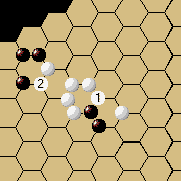- GOAL
-The object of the game is to control as many circles as you can, by spreading your sphere
of influence across the board.
- PLAYERS
- RINGS can be played by two to six players. The players sit around the board, choose
colors, and decide at random who goes first. Play then proceeds clockwise around the
board.
- PLAY
- Each turn consists of two parts. First you may place a stone on the
board, then you have
an opportunity to convert your opponents' stones. Place stones on the points where three
circles intersect.
- The stone is then considered to occupy each of the three circles which
form the intersection.
- RINGS
- Six stones of the same color in one circle form a ring. The stones which form a ring
become safe and may no longer be converted.
- Rings are also important because they increase
your influence on the surrounding circles. You will want to form rings to secure your
position on the board.
- INFLUENCE
- Your influence on a circle is equal to the number of stones you have in that circle plus
the number of rings you have which adjoin it.
- You use influence to convert your
opponents' stones, and to win the game. Each stone exerts influence on three
circles.
- Each ring
exerts influence on six neighboring circles.
- CONVERSION
- On your turn, after placing a stone, you may convert your opponents' stones in any
circles on which you have the majority of influence.
- To determine if you have the majority
of influence on any particular circle, compare your influence on that circle to the total
of your opponents' influences PLUS the number of empty spaces in the
circle.
- Because empty
spaces (intersections without stones) count for the defense, you will always need at least
four points of influence on a circle in order to have the majority. When you convert the
stones in a circle, all of your opponents' stones in that circle are replaced with your
own. Although converting in any particular circle is optional, you must replace ALL of the
opposing stones in each circle in which you convert, with one exception.
- You MAY NOT
convert stones which form opponents' rings, even when you convert other stones in the same
circle.
- You can use the influence you gain by converting to continue converting on the same
turn. A cunning series of conversions can have a dramatic affect.
- ENDING
THE GAME - You may choose to pass your turn, and not place a
stone. This does not
prevent you from converting. When all players pass in sequence, the game is over. Your
score is the number of circles on which you have the majority of
influence. The winner is
the player with the highest score when the game ends. Play is not limited by the number of
stones provided. If you run out of stones before the game ends, simply select a color
which is not in use, and continue playing with that new color. For two and three player
games, choose two colors before the game begins.
|
